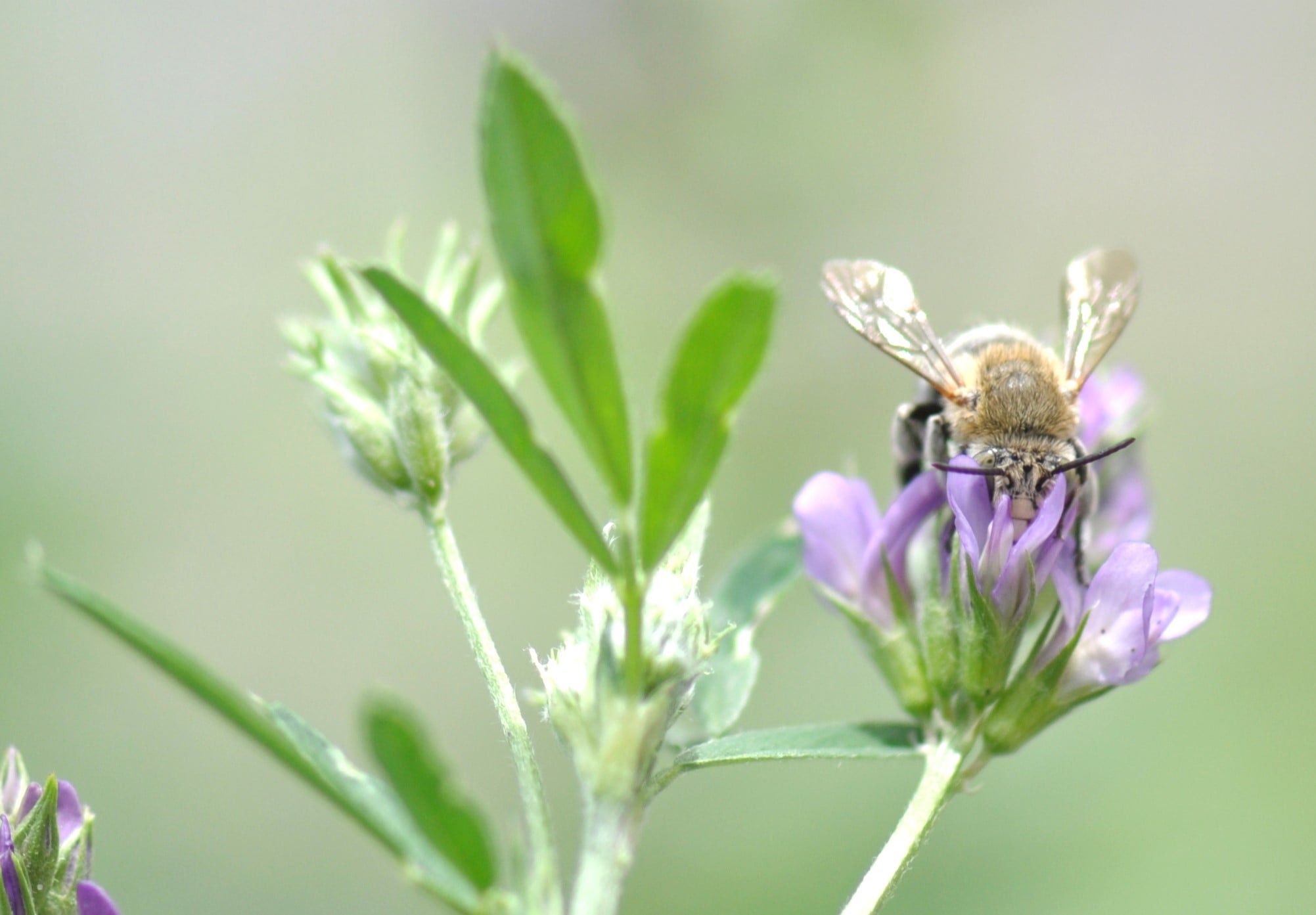Wild pollinators contribute on average A$ 22 M to the production of dryland lucerne seed. The wild pollinators include the feral honey bees and native bee species.
Among the native bees, two blue-banded bee species are particularly abundant in the lucerne growing regions around Keith: the blue-green blue-banded bee (Amegilla chlorocyanea) and Murrray’s blue-banded bee (A. murrayensis). They look alike, but with a little bit of training, the difference is clear:

Abdomen of female blue-green (left) and Murray’s blue-banded bees (Leijs et al 2017)
Do these common blue-banded bee species pollinate lucerne?
Several lines of evidence indicate that only the blue-green blue-banded bee (left above) pollinates lucerne:
- This species has been caught on lucerne flowers – Murray’s bee hasn’t;
- Both male and female blue-green blue-banded bees have been found to carry lucerne pollen on their body, which shows that they have recently tripped flowers;
- Lucerne pollen can be found on the hind legs of female blue-green blue-banded bees. This indicates that they use the pollen to rear their offspring;
- We trialed the two species in captivity for their ability to pollinate lucerne – see below.
Preliminary experiments: The blue-green versus Murray’s blue-banded bee
The blue-green blue-banded bee
In 2006, Katja was using blue-banded bees for greenhouse tomato pollination. Driven by curiosity, she did a pilot study to investigate the ability of the bees to pollinate lucerne. Katja used a single isolation cage with nine blue-green blue-banded bees, and compared the seed yield per 100 plants to a cage containing about 500 foraging honey bee workers (a tiny nucleus hive). Initial results indicated equal set in both cages and a higher seed set per bee for blue banded bees.
Murray’s blue-banded bee
In 2011, with funding from AgriFutures (then RIRDC), the pollination experiment was repeated in two greenhouses. However, in this case, Katja used Murray’s blue-banded bees. Why? Convenience, really. It was the species she was working with at the time, and there was no reason to assume it would make much difference. After all, both are common species, visit other crops, and they look very similar. But the results were unexpected: In captivity, Murray’s blue-banded bees ignored the lucerne flowers, and there was no seed set. However, these results remain preliminary – academic rigour calls for replicated trials in the exact same conditions.
Thus, all evidence indicates that blue-green blue-banded bees are among the wild pollinators of lucerne, while Murray’s blue-banded bee may not be. This implies that enhancing the abundance of blue-green blue-banded bees in and around a crop will lead to more secure crop pollination services. The “Secure Pollination for more Productive Agriculture” project is working to enhance the abundance of crop pollinators through revegetation.
This project is supported by AgriFutures Australia, though funding from the Australian Government Department of Agriculture and Water Resources as part of its Rural R&D for Profit Program, as well as Horticulture Innovation Australia. The project is being led by the University of Adelaide with further support from Adelaide and Mount Lofty Ranges Natural Resources Management Board, Department of Environment Water and Natural Resources SA, Apple and Pear Growers Association (SA), Lucerne Australia, Native Vegetation Council, Natural Resources Northern and Yorke, O’Connor NRM, Primary Industries and Resources SA, South Australian Apiarist Association, Terrestrial Ecosystems Research Network Eco-informatics and Trees For Life.
 Author
Author
Dr Katja Hogendoorn is a Research Associate in the School of Agriculture, Food and Wine, University of Adelaide here at the Waite campus.
This article was originally published on her Wild pollinators of lucerne blog.

Native blue-banded bee pollinating lucerne.
Photo: K. Hogendoorn
